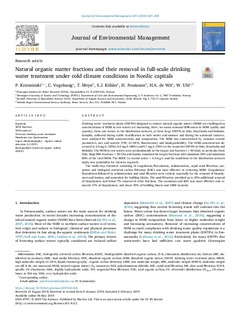Natural organic matter fractions and their removal in full-scale drinking water treatment under cold climate conditions in Nordic capitals
| dc.contributor.author | Krzeminski, Pawel | |
| dc.contributor.author | Vogelsang, Christian | |
| dc.contributor.author | Meyn, Thomas | |
| dc.contributor.author | Köhler, Stephan | |
| dc.contributor.author | Poutanen, Heikki | |
| dc.contributor.author | de Wit, Heleen | |
| dc.contributor.author | Uhl, Wolfgang | |
| dc.date.accessioned | 2019-06-26T13:24:35Z | |
| dc.date.available | 2019-06-26T13:24:35Z | |
| dc.date.created | 2019-05-08T14:07:52Z | |
| dc.date.issued | 2019 | |
| dc.identifier.citation | Journal of Environmental Management. 2019, 241, 427-438. | nb_NO |
| dc.identifier.issn | 0301-4797 | |
| dc.identifier.uri | http://hdl.handle.net/11250/2602375 | |
| dc.description.abstract | Drinking water treatment plants (DWTPs) designed to remove natural organic matter (NOM) are challenged as concentrations of NOM in raw waters are increasing. Here, we assess seasonal differences in NOM quality and quantity, from raw waters to the distribution network, at three large DWTPs in Oslo, Stockholm and Helsinki. Samples, collected during stable stratification in both winter and summer and during the autumnal turnover, were analysed for NOM concentrations and composition. The NOM was characterized by common routine parameters, size and content (TFF, LC-OCD, fluorescence) and biodegradability. The NOM concentration decreased to 2.5 mg/L (55%), 4.0 mg/L (48%) and 5.7 mg/L (76%) at the respective DWTPs in Oslo, Stockholm and Helsinki. The NOM in raw waters were predominantly in the largest size fraction (>50 kDa), in particular from Oslo. High MW fractions >50 kDa and humics remained the largest fractions with minimum 30% and maximum 80% of the total NOM. The BDOC in treated water <0.3 mg/L and the conditions in the distribution network imply low probability for bacteria regrowth. The multi-step treatment consisting of coagulation/flocculation, sedimentation, rapid sand filtration, ozonation and biological activated carbon filtration (BAC) was most effective in removing NOM. Coagulation/flocculation followed by sedimentation and sand filtration were critical, especially for the removal of biopolymers and humics, and somewhat for building blocks. The sand filtration provided up to 25% additional removal of biopolymers and below 7% removal of other fractions. The ozonation and BAC was more effective and removed 11% of biopolymers, and about 35% of building blocks and LMW neutrals. | nb_NO |
| dc.language.iso | eng | nb_NO |
| dc.publisher | Elsevier | nb_NO |
| dc.rights | Navngivelse 4.0 Internasjonal | * |
| dc.rights.uri | http://creativecommons.org/licenses/by/4.0/deed.no | * |
| dc.title | Natural organic matter fractions and their removal in full-scale drinking water treatment under cold climate conditions in Nordic capitals | nb_NO |
| dc.type | Journal article | nb_NO |
| dc.type | Peer reviewed | nb_NO |
| dc.description.version | publishedVersion | nb_NO |
| dc.rights.holder | © 2019 The Authors. | nb_NO |
| dc.source.pagenumber | 427-438 | nb_NO |
| dc.source.volume | 241 | nb_NO |
| dc.source.journal | Journal of Environmental Management | nb_NO |
| dc.identifier.doi | https://doi.org/10.1016/j.jenvman.2019.02.024 | |
| dc.identifier.cristin | 1696399 | |
| cristin.unitcode | 7464,20,16,0 | |
| cristin.unitcode | 7464,30,23,0 | |
| cristin.unitname | Systemer og teknologi | |
| cristin.unitname | Nedbørfeltprosesser | |
| cristin.ispublished | true | |
| cristin.fulltext | original | |
| cristin.qualitycode | 1 |
Tilhørende fil(er)
Denne innførselen finnes i følgende samling(er)
-
Publikasjoner fra Cristin - NIVA [2149]
-
Scientific publications [1172]

